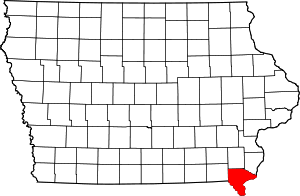Fort Madison Toll Bridge
| Fort Madison Toll Bridge | |
|---|---|
 | |
| Coordinates | 40°37′37″N 91°17′45″W / 40.62694°N 91.29583°W |
| Carries | 2 lanes of IA 2 and IL 9 and rail lines |
| Crosses | Mississippi River |
| Locale | Fort Madison, Iowa and Niota, Illinois |
| Other name(s) | Santa Fe Swing Span Bridge |
| Maintained by | BNSF Railway |
| History | |
| Opened | July 26, 1927 |
| Statistics | |
| Toll | $2.00 (eastbound only) |
The Fort Madison Toll Bridge (also known as the Santa Fe Swing Span Bridge for the old Santa Fe rail line) is a tolled, swinging truss bridge bridge over the Mississippi River that connects Fort Madison, Iowa and unincorporated Niota, Illinois. Rail traffic occupies the lower deck of the bridge, while two lanes of road traffic occupy the upper deck. It is widely considered the longest double-deck swing-span bridge in the world. Completed in 1927, it replaced an inadequate combination roadway/single-track bridge completed in 1887. The main river crossing consists of four 270-foot (82 m) through truss spans and a swing span made of two equal arms, 266 feet (81 m) long. In 1999, it was listed in the National Register of Historic Places under the title, Fort Madison Bridge, structure #99001035. It was also documented by the Library of Congress Historic American Engineering Record, survey number HAER IA-62. Construction and photographic details were recorded at the time in Scientific American magazine.
The bridge is the eastern terminus of Iowa Highway 2, and the western terminus of Illinois Route 9. Iowa 2 runs westwards towards Farmington, Iowa (23 miles/37 km), while Illinois 9 continues eastwards towards Canton, Illinois (~80 mi/129 km) and Peoria (~100 miles/162 km). On July 26, 1927, operations were transferred from the original single track bridge to the current bridge. The first opening for river traffic occurred at 11:58 a.m. on July 26, 1927, for the scow C. W. Howell traveling downriver with no barges attached.
The bridge is privately owned by BNSF Railway and is the river crossing for the Southern Transcon, BNSF's Chicago to Southern California main line. About 100 trains are hosted daily on this bridge. Amtrak's Southwest Chief crosses the bridge with one eastbound train in the morning and one westbound train in the evening. The station is two miles (3 km) to the west of the bridge.
Per Coast Guard regulations and the BNSF Fort Madison River Bridge operations manual, river traffic has the right-of-way over train and vehicle traffic on the bridge. The length of time for an opening varies due to weather, river current, size and number of boats, and occasional mechanical problems. A typical opening for a tow with 15 barges will take 15 to 20 minutes. The bridge logs over 2000 openings per year, an average of more than 5 per day.
Bridge toll is charged only to those crossing from Iowa into Illinois, and depends on the type of vehicle and number of axles the vehicle has. As of March 2009, the rates are: motorcycles 50 cents, automobiles and pick-up trucks $1.00, trucks larger than a pick-up truck are $2.00 per axle, not including the first axle, buses and RVs are $4.00, add $1.00 additional to any fee if towing a trailer, bicycles are free and pedestrians are prohibited from walking on the road or rail decks. All fees are cash only, no passes, checks or credit/debit cards are accepted. Also, any legal vehicles over 8 feet (2.4 m) wide and 14 feet (4.3 m) high are prohibited from crossing the bridge. Currently, there is a weight limit of 30 tons and a prohibition of all semi-tractors and any vehicle over 60 feet in length, of any weight, crossing the bridge. As of March 1, 2012, the toll rates are: motorcycles $1.00, automobiles and pick-up trucks $2.00, cars & pick-up trucks with a trailer $3.00, buses $4.00, RV's & campers $3.00, trucks and utility vehicles $3.00 per axle (excluding the front axle). Tractor-trailer combinations (semis) are not allowed on the bridge and signs stating this are posted on the nearby roadways. The previous toll rates had been in place since the late 1990s and BNSF Railway officials say the toll revenue covers the maintenance costs on the highway portion of the bridge.
See also
- List of crossings of the Upper Mississippi River
- List of road-rail bridges
References
- Historic American Engineering Record (Library of Congress) Survey number HAER IA-62
- Weeks, John. "US-136 Bridge, Keokuk, IA". http://www.johnweeks.com/upper_mississippi/pagesB/umissB11.html. Retrieved January 18, 2006.
- Crews Tackle Mississippi River Bridge Work
-

The Fort Madison Toll Bridge
| |||||||||
| ||||||||||||||||||||||||||
